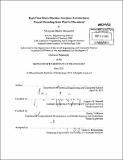Real-time brain-machine interface architectures : neural decoding from plan to movement
Author(s)
Modir Shanechi, Maryam
DownloadFull printable version (14.44Mb)
Other Contributors
Massachusetts Institute of Technology. Dept. of Electrical Engineering and Computer Science.
Advisor
Gregory W. Wornell and Emery N. Brown.
Terms of use
Metadata
Show full item recordAbstract
Brain-machine interfaces (BMI) aim to enable motor function in individuals with neurological injury or disease, by recording the neural activity, mapping or 'decoding' it into a motor command, and then controlling a device such as a computer interface or robotic arm. BMI research has largely focused on the problem of restoring the original motor function. The goal therefore has been to achieve a performance close to that of the healthy individual. There have been compelling proof of concept demonstrations of the utility of such BMIs in the past decade. However, performance of these systems needs to be significantly improved before they become clinically viable. Moreover, while developing high-performance BMIs with the goal of matching the original motor function is indeed valuable, a compelling goal is that of designing BMIs that can surpass original motor function. In this thesis, we first develop a novel real-time BMI for restoration of natural motor function. We then introduce a BMI architecture aimed at enhancing original motor function. We implement both our designs in rhesus monkeys. To facilitate the restoration of lost motor function, BMIs have focused on either estimating the continuous movement trajectory or target intent. However, natural movement often incorporates both. Moreover, both target and trajectory information are encoded in the motor cortical areas. These suggest that BMIs should be designed to combine these principal aspects of movement. We develop a novel two-stage BMI to decode jointly the target and trajectory of a reaching movement. First, we decode the intended target from neural spiking activity before movement initiation. Second, we combine the decoded target with the spiking activity during movement to estimate the trajectory. To do so, we use an optimal feedback-control design that aims to emulate the sensorimotor processing underlying actual motor control and directly processes the spiking activity using point process modeling in real time. We show that the two-stage BMI performs more accurately than either stage alone. Correct target prediction can compensate for inaccurate trajectory estimation and vice versa. This BMI also performs significantly better than linear regression approaches demonstrating the advantage of a design that more closely mimics the sensorimotor system. (cont.) While restoring the original motor function is indeed important, a compelling goal is the development of a truly "intelligent" BMI that can transcend such function by considering the higherlevel goal of the motor activity, and reformulating the motor plan accordingly. This would allow, for example, a task to be performed more quickly than possible by natural movement, or more efficiently than originally conceived. Since a typical motor activity consists of a sequence of planned movements, such a BMI must be capable of analyzing the complete sequence before action. As such its feasibility hinges fundamentally on whether all elements of the motor plan can be decoded concurrently from working memory. Here we demonstrate that such concurrent decoding is possible. In particular, we develop and implement a real-time BMI that accurately and simultaneously decodes in advance a sequence of planned movements from neural activity in the premotor cortex. In our experiments, monkeys were trained to add to working memory, in order, two distinct target locations on a screen, then move a cursor to each, in sequence. We find that the two elements of the motor plan, corresponding to the two targets, are encoded concurrently during the working memory period. Additionally, and interestingly, our results reveal: that the elements of the plan are encoded by largely disjoint subpopulations of neurons; that surprisingly small subpopulations are sufficient for reliable decoding of the motor plan; and that the subpopulation dedicated to the first target and their responses are largely unchanged when the second target is added to working memory, so that the process of adding information does not compromise the integrity of existing information. The results have significant implications for the architecture and design of future generations of BMIs with enhanced motor function capabilities.
Description
Thesis (Ph. D.)--Massachusetts Institute of Technology, Dept. of Electrical Engineering and Computer Science, 2011. Cataloged from PDF version of thesis. Includes bibliographical references (p. 129-135).
Date issued
2011Department
Massachusetts Institute of Technology. Department of Electrical Engineering and Computer SciencePublisher
Massachusetts Institute of Technology
Keywords
Electrical Engineering and Computer Science.